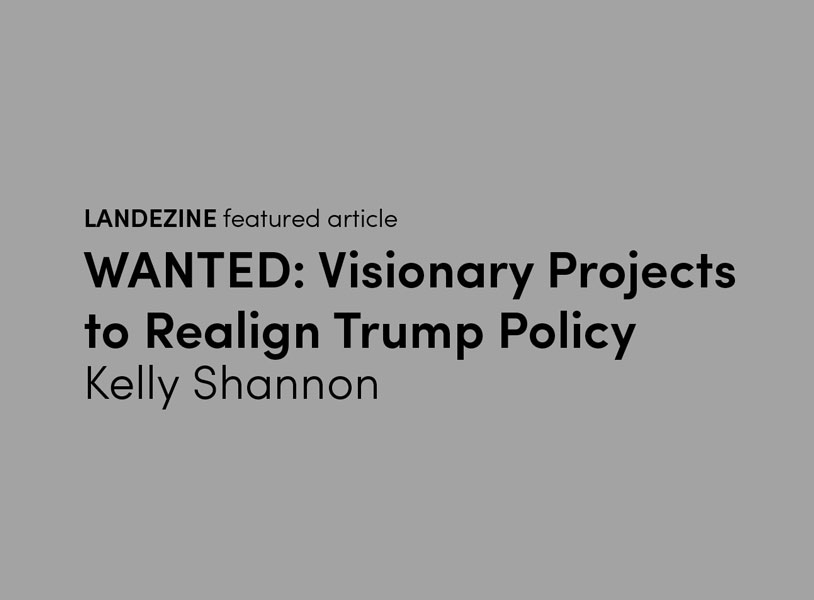https://urbannext.net/wanted-visionary-projects-to-realign-trump-policy/
| WANTED: Visionary Projects to Realign Trump Policy https://urbannext.net/wanted-visionary-projects-to-realign-trump-policy/ |

Categories: Energy and sustainability, Essay, expanding design practices, Kelly Shannon, No Density, Politics and economics, Urban Paradigms
The Trump administration, in its refusal to recognize climate change as an eminent threat to the planet, is forging a full-fledged assault on the environment. Ecological policies, decades-in-the-making and their respective regulating agencies, are at risk of vanishing. Nearing a 100 days in office, the White House has launched countless anti-environmental actions, amongst which are those that will most likely completely dismantle the Environmental Protection Agency, expand mining, drilling, and logging on public lands, and derail former president Barak Obama’s hard-won progress towards climate change mitigation (including withdrawing and rewriting the U.S. commitment to the 2015 United Nations Paris Agreement, and the Clean Power Plan amongst others). Against this sinister backdrop, there has been an explosion of environmental activists and organizations which are joining forces with social justice groups to wage a counterattack. Their union underscores a belief that the forces looming over the environment are the same that engender social, racial and economic inequality. It explains why veterans and the Black Lives Matter network stand in solidarity with Native Americans to protect rights to clean water and clean air. A remarkable surge of grassroots energy has given groups such as Greenpeace and 350.org a stronger voice than the more traditional environmental advocacy groups, such as the Natural Resources Defense Council and Environmental Defense Fund. Attending their protest marches is invigorating; yet as part of the design world there is a need to do more. Now more than ever, landscape architects and urbanists must develop projects that address social and environmental justice, despite – or because of – the stripping away of protections to the planet and its valuable resources.
"Now more than ever, landscape architects and urbanists must develop projects that address social and environmental justice, despite – or because of – the stripping away of protections to the planet and its valuable resources."
Richard Nixon, a staunch Republican, created the Environmental Protection Agency (EPA) in 1970. The agency came into being at a time of serious environmental degradation due to widespread air and water pollution. Massive public awareness helped support enactment of the agency’s two most infamous laws: the Clean Air Act (1970) and Clean Water Act (1972). These and other federal mandates, including the Coastal Zone Management Act (1972), the Endangered Species Act (1973), and Water Resources Planning Act (1977) have since become cornerstones of American environmentalism. But after fifty years of environmental policy and monitoring, crucial protections that Americans have come to rely upon for their health and safety are in jeopardy of disappearing.
Whether economic policy will ever see eye-to-eye with environmental policy is questionable especially with Trump’s renegade cabinet appointees and his effort to buoy America’s struggling coal industry. Since taking office, Scott Pruitt, Director of the EPA, ally of the fossil fuel industry and key strategist against climate initiatives, has openly denounced carbon dioxide as the primary contributor to climate change. Consequently, Pruitt is seeking to cut the EPA’s budget nearly 31% (from $8.1 billion to $5.6 billion) and reduce its staff by 25 percent (3,200 jobs). Meanwhile, Ryan Zinke, Secretary of the Interior, steward of 500 million acres of the U.S. (roughly one fifth of the nation) is charged with balancing the contradictory notions of conserving land and extracting resources from it. Rex Tillerson, Secretary of State, has his own controversial history as ExxonMobil’s CEO which is plaguing its early knowledge of climate change dangers to the environment.
"There is more to come from Trump and his administration with regards to dismantling stewardship of the American landscape and protection of natural resources."
Trump has signed a number of executive orders that the administration is playing up for job creation potential and the increase of US energy independence. Jurists note that they will not unravel Obama plans in one fell-swoop, but set in motion a legal quagmire of environmental deregulation. On February 28th, the executive order ‘Restoring the Rule of Law, Federalism, and Economic Growth by Reviewing the “Waters of the United States” Rule’ will have the EPA and the Army Corps of Engineers revisit the Clean Water Law. Both Presidents George W. Bush and Obama had expanded federal jurisdiction to include wetlands, rivers and streams that fed into ‘navigable waters’ due to pollution and public health concerns. A second executive order by Trump, exactly one month later, was another, longer and much more extensive. The ‘Promoting Energy Independence and Economic Growth’ order instructs the Bureau of Land Management to lift a moratorium on new coal mining on federal lands; disbands the Interagency Working Group on the Social Cost of Greenhouse Gases, the group that set forth a ‘social cost of carbon (SCC)’; removes the consideration of greenhouse gases from permit reviews under the National Environmental Policy Act; and formally abandons Obama’s roadmap on how to achieve U.S. emissions reductions. It contains several other daunting details, the dire consequences of which will only become apparent once all the legalese is worked through. It is anyway clear that there is more to come from Trump and his administration with regards to dismantling stewardship of the American landscape and protection of natural resources.
The wholesale rollback of environmental safeguards will allow corporations to return to an era of reckless unaccountability and jeopardizes the health of humanity and more importantly, of the planet. Now, more than ever there is a necessity for landscape architecture. The key is at the territorial and regional scale and the creation of visionary projects which can address issues of climate change, food and water security and new energy and infrastructure landscapes.
| ISSN : 2575-5374 |